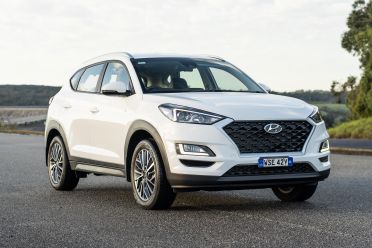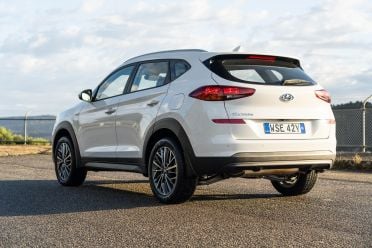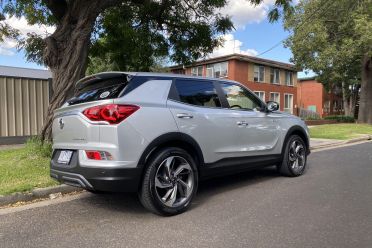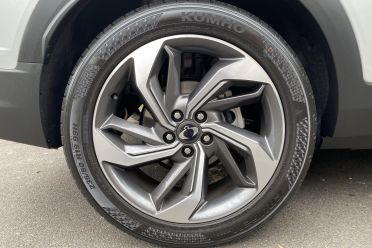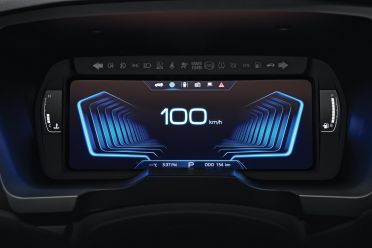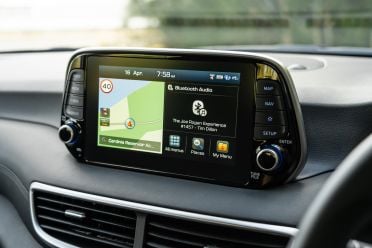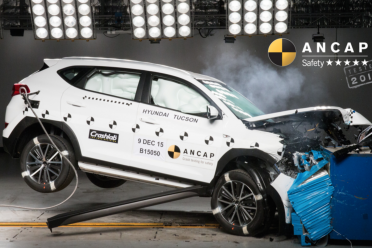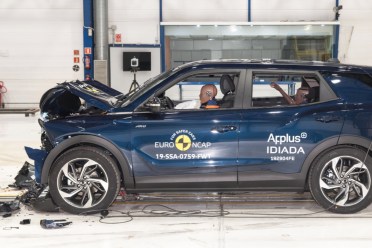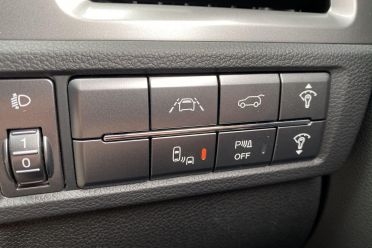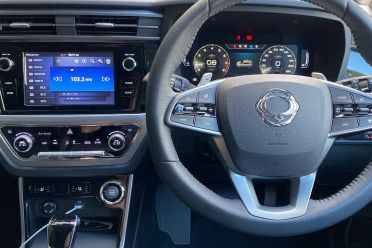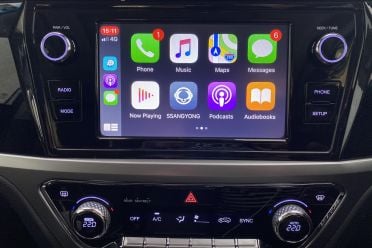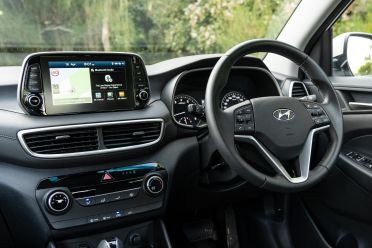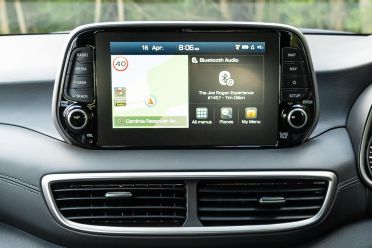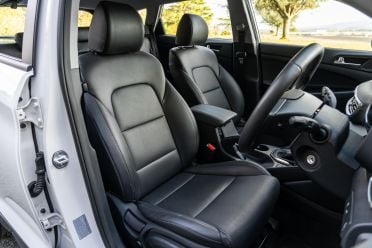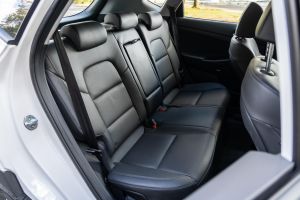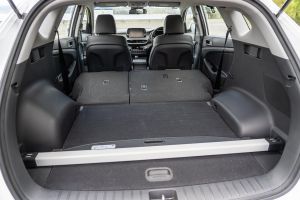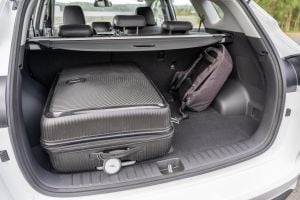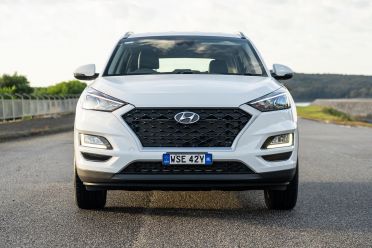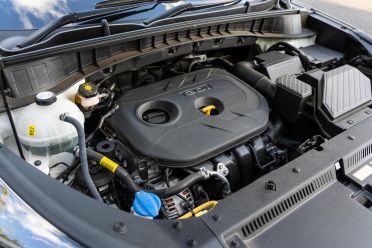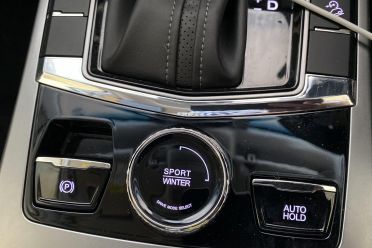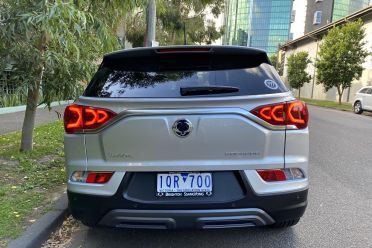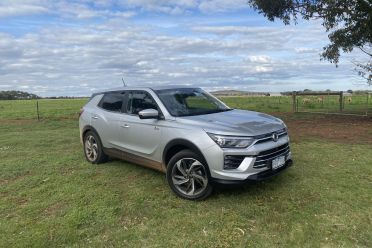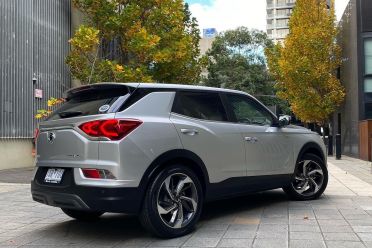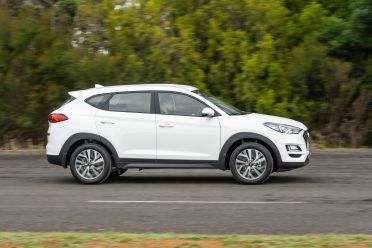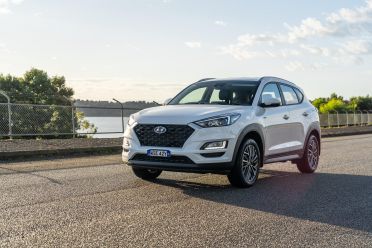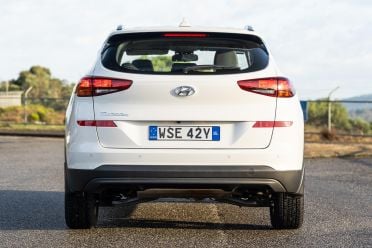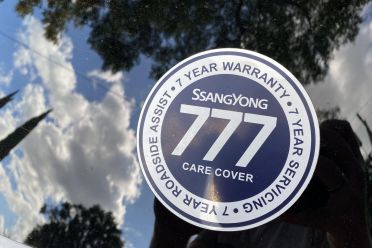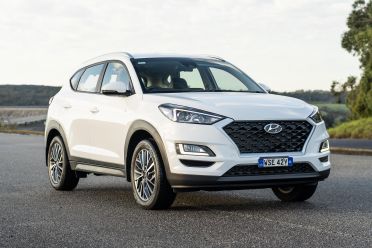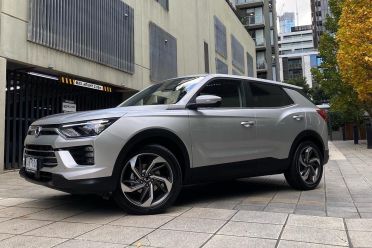The question we want to answer with this test is, can the relatively unknown SsangYong Korando compete against its much better-known, fellow Korean mid-sized SUV contender?
Industry followers know Hyundai this week revealed its new-generation Tucson, which is a much edgier and premium proposition. But it doesn’t arrive until 2021, meaning there’s plenty of time to get an outgoing model at a discounted runout price.
Dare I say it, that’s the likely target buyer for the SsangYong too.
How much?
The Korando range kicks off with the EX at $26,990 drive-away, plus $2000 for an automatic. From there it’s another $2000 into the auto-only ELX ($30,990 drive-away), up to $36,990 drive-away for the Ultimate range-topper. It’s this grade on test here.
That makes it more than $10,000 cheaper than a range-topping Tucson Highlander. Instead, it lines up against a second-from-base rung Tucson Active X, with a list price of $35,140 but currently available for $34,990 drive-away.
The question then becomes sharper: top-of-the-range Korando or just-above-base Tucson for similar coin? Let’s be real: SsangYong would likely do a deal to square them up.
What do you get?
Outside, both the Korando Ultimate and Tucson Active X have alloy wheels (18-inch diameter for the Hyundai, and 19-inch for the SsangYong), and projector headlights.
The SsangYong adds a heap of extras including rain-sensing wipers, a smart proximity key fob with button start, rear privacy glass, a glass sunroof, and a one-touch electric tailgate. The Tucson X has none of these, meaning you need to step into pricier grades if you want them.
Inside, both cars get leather-trimmed seats with manual adjustment, reversing cameras, 8.0-inch touchscreens, and Apple CarPlay and Android Auto phone mirroring.
The SsangYong alone offers climate control instead of manual air-conditioning, heated and ventilated front seats, heated rear seats, a heated steering wheel, fully digital LCD driver instruments, and adaptive cruise control instead of passive. The Hyundai counters with factory satellite-navigation, two more speakers (eight versus six), and DAB digital radio.
The SsangYong offers a lot more equipment for the money.
Are they safe?
SsangYong
ANCAP gave the Korando a five-star rating using 2019 criteria. The score included 88 per cent for adult protection, 86 per cent for child protection, 72 per cent for safety assist, and 68 per cent for vulnerable road-user protection.
The Tucson also has a five-star ANCAP rating, but one conducted against earlier 2015 protocols, without specific breakdowns like those listed above.
Features found in both cars include dual front, front-side, and full-length curtain airbags. The Korando also has a seventh airbag, for the driver’s knee. Each car also has city-speed autonomous emergency braking (AEB), lane-keeping assistance, and a driver-attention monitor.
Both cars’ rear seats come with outboard ISOFIX child-seat anchor points and the requisite top tethers.
Over this suite the SsangYong alone adds a radar system to its AEB that works at higher speeds and is tested in the ANCAP report here, as well as blind-spot monitoring, rear cross-traffic alert, and a front-vehicle start alert that beeps if the vehicle ahead departs a static situation and you don’t.
| Hyundai Tucson Active X | SsangYong Korando Ultimate | |
|---|---|---|
| AEB urban | Yes | Yes |
| AEB inter-urban | No | Yes |
| Blind-spot monitor | No | Yes |
| Rear cross-traffic alert | No | Yes |
| Lane-keeping assist | Yes | Yes |
| Active cruise control | No | Yes |
| Driver-alertness monitor | Yes | Yes |
What are they like inside?
SsangYong
The manually-adjustable leather seats and steering wheel offer decent breadth of movement to enable good ergonomics. Storage needs are catered for by 1.5-litre bottle-swallowing door bins, a glovebox, and a shelf ahead of the shifter.
The build quality and panel consistency is fine. What lets its down are the hard plastics along the transmission tunnel and lower dash, glossy black trims that are a magnet for dust and scratches, and the flimsy interior door handles.
The infotainment also offers a good-resolution rear camera and you can mirror your phone via Apple CarPlay or Android Auto. There is however only one USB point and no digital radio receiver, nor is there integrated sat-nav.
The 10-inch digitised driver’s instruments are very swish, offering the ability to cycle through various looks and information screens.
Below the centre screen is a dual-zone climate control system which you adjust with nicely damped buttons and knurled dials. This design carries over to the transmission tunnel, where you’ll find a dial to control the driving mode and buttons for the electric parking brake and the anti-creep auto hold function.
It’s hard to complain too much about back seat space, which is generous. At 4450mm long the Korando is actually quite small for the class, but you wouldn’t know it. I’m 194cm and had sufficient leg- and headroom. It would be nice to have rear vents and USB ports, though.
The two-stage boot offers a generous 551L of storage. The back seats also fold down to create a bigger storage area of 1248L. However, there is no spare wheel – just a patch kit.
Hyundai
The Hyundai’s manual seat and wheel adjustments are sufficiently broad, and there’s no shortage of spots to stash your stuff.
Subjectively the cabin looks a little more elegant than the SsangYong’s, though it’s also quite monotone and bordering on sparse. The lack of a start button (you put the key in the barrel) and the manual air conditioning controls feel a bit dated.
It’s well put together, and the materials feel like they’ll stand up to years of abuse. It feel a smidgen more polished overall. Given the gap in relative research and development budgets between the brands, that shouldn’t surprise anyone.
There’s are also some attempts to add a veneer of ‘premium’ in the form of padded dash material and splashes of silvery brightwork. The gear shifter is nicely finished with leather wrapping, and the absence of so much shiny glossy plastics is ideal for my tastes. The Tucson retains a manual pull-up handbrake.
The screen is perched atop the dash, and in terms of user interface and breadth of functionality offers more than the SsangYong’s does. Its Infinity sound system with eight speakers also offers crisper audio quality.
There’s a little more headroom in the rear sets because of the lack of a sunroof, but legroom between the pair is comparable. Like the Korando, the Tucson Active X lacks rear-seat vents and USBs, and naturally also lacks the SsangYong’s rear-seat heating too.
Boot space is a smidgen below the SsangYong’s at 488L, but it expands to a super 1478L with the back seats folded 60/40. The Hyundai also offers a clever storage solution for its retracting cargo over, and has a full-size alloy spare wheel and tyre that’s of massive benefit to regional buyers in particular.
| Hyundai Tucson Active X | SsangYong Korando Ultimate | |
|---|---|---|
| Length | 4480mm | 4450mm |
| Width | 1850mm | 1870mm |
| Height | 1655mm | 1620mm |
| Wheelbase | 2670mm | 2675mm |
| Weight | 1550kg | 1435kg |
| Gross vehicle mass | 2060kg | 2040kg |
| VDA cargo space | 488L – 1478L | 551L – 1248L |
| Ground clearance | 172mm | 182mm |
What’s under the bonnet?
SsangYong
Diesel is available, but the majority of buyers interested in this segment opt for petrol power. So our test car is fitted with a 1.5-litre turbo-petrol engine making 120kW of power and a healthy 280Nm of torque at 1500rpm.
This is mated to a six-speed automatic supplied by Aisin, and is sold for now at least as front-wheel drive only. Towing capacity is 1500kg.
The fuel economy has been independently tested as 7.7 litres per 100km. It has expensive tastes, requiring 95 RON premium petrol.
Hyundai
You can also get diesel in the Hyundai (and a more powerful 1.6-litre turbo petrol in higher-end Tucson models) but our tester packs the only petrol option available in the Active X – a naturally-aspirated 2.0-litre four-cylinder making 122kW of power but an inferior 205Nm of torque at a higher 4000rpm.
It’s likewise mated to a six-speed automatic, and is front-wheel drive. All-wheel drive is the sole province of the higher-grades’ turbo-petrol and diesel engines. The Active X is rated to tow 1600kg.
Fuel economy on the lab-tested combined-cycle is 7.9L/100km, and unlike the SsangYong it’ll happily run on regular 91 RON unleaded.
| Hyundai Tucson Active X | SsangYong Korando Ultimate | |
|---|---|---|
| Engine | 2.0 naturally aspired petrol | 1.5 turbocharged petrol |
| Power | 122kW @ 6200rpm | 120kW @ 5500rpm |
| Torque | 205Nm @ 4000rpm | 280Nm @ 1500 rpm |
| Transmission | 6AT | 6AT |
| Drive | FWD | FWD |
| Fuel economy | 7.9L/100km 91 RON | 7.7L/100km 95 RON |
| Fuel tank | 62L | 47L |
| Towing capacity | 1600kg | 1500kg |
How do they drive?
SsangYong
Being a small-displacement turbo engine, it takes a second to really respond to hard throttle inputs, but it has a strong mid-range that makes it feel more effortless and less breathless on the move than the aspirated Tucson.
The cabin is largely free of engine vibration as well. The difference in throttle uptake and transmission shift points from the various driving modes felt negligible. For an urban runabout and freeway cruiser, it’s absolutely fine. The option of all-wheel drive would be appreciated at update time, though.
I’ve found the ride quality in the larger SsangYong Rexton to be a little fidgety and stiff, but the Korando makes a better case.
The all-round independent suspension is quite sorted, with acceptable damper control over speed bumps smoothing out the ride despite the slim-sidewall Kumho tyres. When I ran over a nearby pothole I was surprised at how few of the inputs made it through to the seat and through the steering column.
It also feels agile enough when you throw it into corners, although the light steering doesn’t communicate what the front wheels are doing well. It can steer itself hands-free around sweeping corners using its lane-keeping aid, though of course you should never take your hands from the wheel.
Hyundai
The Hyundai’s direct-injected engine is more immediately responsive in stop/start conditions, but lacks a broad slab of torque across the rev band, meaning if you want to move somewhere fast you need to apply more throttle, longer. That diminishes refinement.
It really is just a high-riding hatchback without the option of all-wheel drive – particularly Hyundai’s excellent system with its 50:50 torque-splitting lock mode. For those who want more punch, the Elite grade comes with a 130kW/265Nm 1.6-litre turbo and DCT.
The Tucson has all-round independent suspension and its Nexen tyres have a smidgen (5mm) more sidewall. It also has springs, dampers, bushes and bars specifically tuned by an Australian engineering team, based in Sydney.
While the Korando has acceptable body control, generally good bump isolation, and decent NVH suppression, the Tucson offers more ride comfort and slightly more stable handling nearer the limit, and additional steering resistance.
It’s one of the better SUVs to drive out there in its Australian-market guise, very hatch-like albeit with a more commanding driving position.
| Hyundai Tucson Active X | SsangYong Korando Ultimate | |
|---|---|---|
| Front suspension | MacPherson strut | MacPherson strut |
| Rear suspension | Multi-link w/stabiliser | Multi-link w/stabiliser |
| Front brakes | Ventilated disc | Ventilated disc |
| Rear brakes | Solid disc | Solid disc |
| Turning circle | 11m | 10.7m |
| Front/rear track | 1608mm/1620mm | 1590mm/1610mm |
| Spare wheel | Full-size alloy | Tyre inflator and patch kit |
Cost of ownership
SsangYong
SsangYong’s factory distributor backs itself with an impressive seven-year warranty. This is clearly a policy crafted to improve resale value, which is always a thorn in the side for low-profile brands looking to get market traction.
It offers capped-price servicing for the first seven visits at intervals of 12 months or 15,000km. Each service costs a reasonable $295, which isn’t as cheap as Toyota but is far from the most expensive in the segment.
While the brand has expansion plans for Australia, at present it has a smallish dealer network for service support. On its website you can find 46 sites.
Hyundai
Hyundai’s factory warranty is five years with no distance limit.
Servicing intervals are the same as the SsangYong’s at 12 months/15,000km (unlike the 1.6 turbo Tucson). The first three visits are presently advertised at $280, the fourth at $410, the fifth $280, the sixth $350, and the seventh $290.
Hyundai also offers servicing plans that let you pay for the first few visits at purchase time, either in cash or through your finance.
CarExpert’s Pick
The SsangYong Korando answers the question we set out to answer with a ‘yes’: it’s a thoroughly respectable SUV made by a minnow brand that’s outdone itself.
For the outlay it offers far more standard features than the Hyundai, despite both being made in the same country (South Korea). It also offers more safety tech, a better warranty, and a more torque-rich turbo engine.
However, if it were my money I’d still go the Tucson – not just because it’s a bit smoother to drive and has better infotainment, but because it’s hard to quantify the benefit of buying from a brand with dealers everywhere, and decades of unbroken history to draw upon. Not just in resale terms either.
In short: if your psychology places brand recognition as a high priority like mine does, then the Hyundai wins. If it’s an equation asking which family SUV purely offers more for the money, then the SsangYong wins. Which I must say is a mightily good effort.




